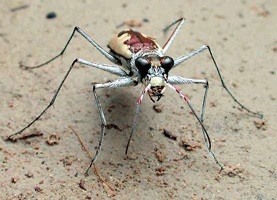The Italian weekly magazine Oggi published a colorful spread about the Census of Marine Life in its 26 June 2006 edition entitled “ET swims in the abyss.” The opening page includes a photo of Jesse about to go to work on an arctic ice floe.
Blog
CoML Marine Microbes
The Census of Marine Life announces discovery of a rare microbial biosphere. Jesse notes that a swallow of seawater might contain 1000 kinds of bacteria.
Scientific American SuperGrid
The Continental Supergrid is featured in the July 2006 issue of Scientific American:
ENERGY
A Power Grid for the Hydrogen Economy
By Paul M. Grant, Chauncey Starr and Thomas J. Overbye
Cryogenic, superconducting conduits could be connected into a
“supergrid” that would simultaneously deliver electrical power
and hydrogen fuel.
We are delighted that the Supergrid concept has advanced strongly from the November 2002 and October 2004 feasibility workshops.
Elektron Splicer
Our 1996 paper Elektron introduced the notion of an appliance, “The Splicer”, a multipurpose minigenerator at the level of the individual consumer that could produce heat, electricity, and cold on demand, and help the electric power system for peaking and standby and thus reliability. We are delighted to find engineer Andreas Gratzer of the Austrian company OMV has developed a working splicer of 70,000 rpm and 115 kw. A German report details his thinking.
Barcode libraries grow on the web
The All Birds Barcoding Initiative (ABBI) website barcodingbirds.org provides a continuously updated progress report on barcoding world birds. A live feed matches barcodes deposited in the

Barcode of Life Data Systems (BOLD) to a checklist of world birds. barcodingbirds.org visitors can view world and regional progress reports, progress by orders and families, and detailed results for individual species including zoomable Google world maps showing where barcodes were collected. A link out to species pages in Integrated Taxonomic Information System (ITIS) is provided.
A sibling website fishbol.org provides live updates for the Fish Barcode of Life initiative (FishBOL) which aims to collect barcodes from all fishes, approximately 30,000 species.
![]()
In addition to assisting researchers scattered across the globe track progress and coordinate efforts, these sites will interest many other persons. They link an enormous amount of taxonomic information with growing genetic databases derived from museum collections. The instant Google maps provide a early glimpse of what these sites can do. Future tools will overlay genetic differences in mitochondrial DNA barcodes on top of the geographic map. These “mashups” of traditional taxonomy, widely-accessible species identification through genetic barcode analysis, and user-friendly visualization will have many viewers.
Minimalist DNA barcodes to help with museum specimens
Analyzing shorter barcode sequences is an inexpensive way to link museum specimens with degraded DNA to the barcode database. In Molecular Ecology Notes July 2006, Hajibabaei et al first demonstrate in silico that COI sequences as short as 109 base pairs contain enough information to assign most specimens to known species, using simulated “minibarcodes” taken from two full-length barcode datasets. The researchers then analyzed the recovery and performance of various lengths of “minibarcodes” amplified from 33 dried and 91 ethanol-preserved insect specimens ranging in age from 1 to 21 years. As shown in the below, although full-length barcodes were recovered from only 24-39% of specimens, there was encouragingly high success amplifying shorter segments.

As expected from the in silico analysis, in most cases species could be distinguished as well as with full-length barcodes, ie sequences formed distinct non-overlapping clusters in a NJ tree. Hajibabaei et al’s results indicate that analyzing shorter minibarcode sequences can link museum specimens with degraded DNA to the gold standard full-length barcode database. Rather than spend time and money optimizing primers and amplification conditions on individual specimens, instead apply a general method that recovers a 100-400 bp fragment. They point out this approach will be useful “when barcoding reveals several cryptic species within what had been viewed as one species, and it is not morphologically evident which of them matches the holotype” and as “a cost-effective way of building barcode libraries with broad geographical coverage”. They caution that “very short barcode sequences are..valuable for the identification of old specimens from SELECTED NARROW taxonomic arrays” (emphasis added)
I agree a mini-barcode approach can be useful in certain situations, and emphasize their caution that it is not a substitute for a standardized full-length barcode database. First, if widely used, a minimalist approach could easily devolve into a Tower of Babel, with a hodgepodge of non-overlapping minibarcodes that cannot be compared to each other. Second, even if the minibarcodes were standardized so they all overlapped, a simple calculation implies that they would lump together most species with less than 1% sequence difference (in birds, this is about 15% of species). Less than 1% sequence difference means less than 6.5 diagnostic differences with a full-length barcode, and assuming randomly distributed substitutions, a shorter barcode could easily fail to capture any diagnostic differences.
Some taxonomists begin to worry less
In 21 June 2006 Heredity News and Commentary “DNA barcodes: recent successes and future prospects” Dasmahapatra and Mallet describe the DNA barcoding initiative as “plausible and worthwhile” and conclude that “recent studies convincingly demonstrate the efficacy of DNA barcoding to recover biologically significant groupings or species”. Their generally positive review stumbles near the end with a call “to supplement the mtDNA-based barcode with nuclear barcodes.” This is an impractical proposal of uncertain benefit. First of all, routinely adding a “nuclear barcode”, if one were to be found, would be solving a problem that does not exist, as there are few cases so far in which an mtDNA COI barcode does not distinguish closely-related species. Of  course these exceptional cases need further taxonomic study “integrating DNA sequencing, morphology, and ecologic studies”. Secondly, although over 30 years of research demonstrate the broad utility of mtDNA in delimiting animal species, no one has yet identified a nuclear locus that can regularly distinguish closely-related species, as Dasmahapatra and Mallet acknowledge.
course these exceptional cases need further taxonomic study “integrating DNA sequencing, morphology, and ecologic studies”. Secondly, although over 30 years of research demonstrate the broad utility of mtDNA in delimiting animal species, no one has yet identified a nuclear locus that can regularly distinguish closely-related species, as Dasmahapatra and Mallet acknowledge.
Most of the topics in their review are analyzed in our 2005 brochure “Barcoding Life, Illustrated” which outlines the benefits and limitations to DNA barcoding, including a section on “Why barcode animals with mitochondrial DNA?” .
Establishing a DNA standard barcode for land plants
 Plant researchers from 11 world herbaria are investigating DNA regions for their potential as barcodes for land plant species. From the project rationale: “although the mitochondrial gene region, CO1 ( cox1 ), has already been used with considerable success across a range of animal groups and shows promise in at least some algal groups, it is characterized by relatively low rates of sequence divergence in land plants. Mitochondrial DNA in land plants also undergoes rearrangements, exhibits incorporation of foreign genes and frequent transfer of some genes to the nuclear genome. It is therefore desirable to find an alternative region or, if necessary, regions from one of the other genomes that would be suitable as a barcode.”
Plant researchers from 11 world herbaria are investigating DNA regions for their potential as barcodes for land plant species. From the project rationale: “although the mitochondrial gene region, CO1 ( cox1 ), has already been used with considerable success across a range of animal groups and shows promise in at least some algal groups, it is characterized by relatively low rates of sequence divergence in land plants. Mitochondrial DNA in land plants also undergoes rearrangements, exhibits incorporation of foreign genes and frequent transfer of some genes to the nuclear genome. It is therefore desirable to find an alternative region or, if necessary, regions from one of the other genomes that would be suitable as a barcode.”
This project aims to establish a standard DNA barcode for land plants. Phase 1, completed in December 2005, was a survey of regions that have potential as land plant barcodes. Phase 2, to be completed by January 2007, is to “ground test” the most promising regions in a series of parallel case studies that incoporates representatives of all major land plant lineages.
If this competition is successful, it should be relatively straightforward (ie fast and inexpensive) to compile a comprehensive library of plant DNA barcodes, as there are only about 500,000 known plant species, the world catalog is thought to be essentially complete, and there are several herbaria with large specimen and DNA collections.
CoML Venice
We post the text (but not slides and movies) from Jesse’s talk “How to Census Marine Life” delivered in Venice 15 June 2006 under the auspices of the European Regional Implementation Committee for the Census of Marine Life (Euro-CoML) and Telecom Italia’s Progetto Italia.
mtDNA sequences can define insect species
 DNA-based species descriptions could enable a catalog of life on Earth. Without some sort of automated approach, I believe this goal is unattainable. Insects are a good place to start testing an automated sequence-based approach, as there are about 1 million insect species already described, and probably several million more to go. In upcoming August 2006 Systematic Biology Pons et al examine genus Rivacindela tiger beetles in Australia, providing an explicit test of a DNA sequence-based approach to defining species. They analyzed 468 individuals from 65 sites, using sequence data from 3 mitochondrial genes including DNA barcode region of COI, and found sequence variation was strongly partitioned between 46 or 47 putative species, using a novel tree-based, quantitative method of species recognition based on fixed unique diagnostic characters. Most (40 to 43) of the species entities were recovered by analyzing the three gene regions separately; COI alone produced the closest match to the full data set. The putative species defined by sequence data exhibited biological properties of species in terms of geographic ranges and known morphologic characters. Average divergence within species was .5%, much lower than average among species of 6.3% and between sister species of 2.2%. The sequence analysis took 3 days on a desktop computer, so if this approach proves useful, it can be a benchmark for testing faster methods.
DNA-based species descriptions could enable a catalog of life on Earth. Without some sort of automated approach, I believe this goal is unattainable. Insects are a good place to start testing an automated sequence-based approach, as there are about 1 million insect species already described, and probably several million more to go. In upcoming August 2006 Systematic Biology Pons et al examine genus Rivacindela tiger beetles in Australia, providing an explicit test of a DNA sequence-based approach to defining species. They analyzed 468 individuals from 65 sites, using sequence data from 3 mitochondrial genes including DNA barcode region of COI, and found sequence variation was strongly partitioned between 46 or 47 putative species, using a novel tree-based, quantitative method of species recognition based on fixed unique diagnostic characters. Most (40 to 43) of the species entities were recovered by analyzing the three gene regions separately; COI alone produced the closest match to the full data set. The putative species defined by sequence data exhibited biological properties of species in terms of geographic ranges and known morphologic characters. Average divergence within species was .5%, much lower than average among species of 6.3% and between sister species of 2.2%. The sequence analysis took 3 days on a desktop computer, so if this approach proves useful, it can be a benchmark for testing faster methods.